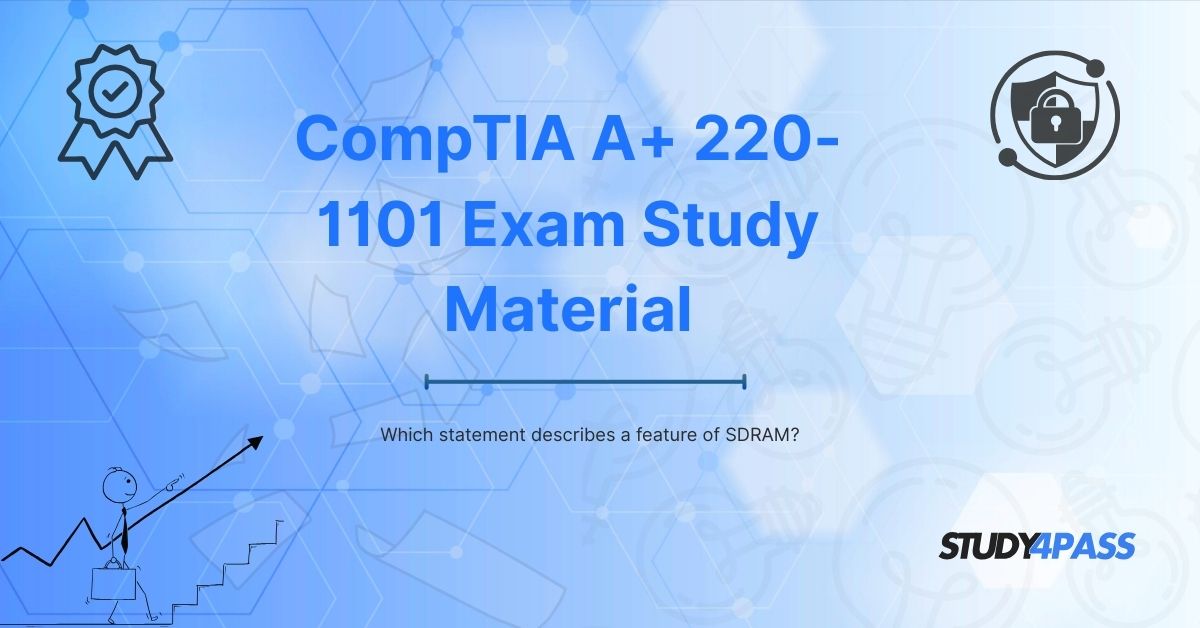Introduction
Synchronous Dynamic Random-Access Memory (SDRAM) is a crucial component in modern computing systems. It plays a vital role in ensuring smooth and efficient data processing by synchronizing with the system's clock speed. For individuals preparing for the CompTIA A+ 220-1101 certification, understanding SDRAM is essential as it forms a foundational topic in hardware and memory management.
This article will explore which statement describes a feature of SDRAM, its significance in computing, and how platforms like Study4Pass can help aspiring IT professionals master such concepts efficiently.
What is SDRAM?
SDRAM stands for Synchronous Dynamic Random-Access Memory. Unlike traditional DRAM, which operates asynchronously, SDRAM synchronizes with the computer's system bus clock, leading to faster and more efficient data transfer rates.
Key Features of SDRAM
- Synchronization with the System Clock
- The most defining feature of SDRAM is that it operates in sync with the CPU's clock cycle.
- This synchronization allows for predictable timing, improving data transfer efficiency.
- SDRAM is faster than conventional DRAM because it can process multiple memory accesses in a single clock cycle.
- This is achieved through burst mode operations, where data is read or written in sequential blocks.
- SDRAM uses pipelining to overlap data access operations, reducing latency.
- This means that while one set of data is being processed, the next set is already being prepared.
- SDRAM is divided into multiple independent memory banks.
- This allows the CPU to access different banks simultaneously, improving multitasking performance.
- Like all forms of DRAM, SDRAM is volatile, meaning it loses stored data when power is turned off.
- Modern SDRAM has evolved into DDR (Double Data Rate) SDRAM, which transfers data on both the rising and falling edges of the clock signal, doubling bandwidth.
Which Statement Describes a Feature of SDRAM?
When studying for the CompTIA A+ 220-1101 exam, you may encounter a question like:
"Which of the following statements describes a feature of SDRAM?"
Possible options could include:
- A) It operates asynchronously with the system clock.
- B) It synchronizes with the CPU's clock speed for faster data access.
- C) It does not require constant refreshing to retain data.
- D) It is non-volatile memory.
This is because SDRAM's primary feature is its synchronous operation, which distinguishes it from older asynchronous DRAM.
Why is SDRAM Important for CompTIA A+ 220-1101?
The CompTIA A+ 220-1101 exam covers essential hardware and memory concepts, including:
- Different types of RAM (SDRAM, DDR, SRAM, etc.)
- Memory speeds and latencies
- System performance optimization
Understanding SDRAM helps IT professionals:
- Troubleshoot memory-related issues (e.g., slow performance, system crashes).
- Upgrade systems efficiently by selecting the right RAM type.
- Optimize system performance by leveraging SDRAM’s synchronous capabilities.
How Study4Pass Helps You Master CompTIA A+ Concepts?
Preparing for the CompTIA A+ Exam requires structured learning and reliable study materials. Study4Pass is an excellent platform that offers:
- Comprehensive Study Guides – Detailed explanations of SDRAM and other key topics.
- Practice Exams – Simulate real test conditions to assess your knowledge.
- Flashcards & Quizzes – Reinforce memory retention with interactive learning.
- Expert Tips & Tricks – Learn from industry professionals on how to tackle exam questions.
By using Study4Pass, you can confidently prepare for your certification and gain a deep understanding of SDRAM and other critical IT concepts.
Conclusion
SDRAM is a fundamental memory technology that enhances computing performance through synchronous operation, pipelining, and multi-bank architecture. For CompTIA A+ 220-1101 candidates, mastering SDRAM is essential for both exams and real-world IT troubleshooting.
Platforms like Study4Pass provide the necessary resources to simplify learning and ensure exam success. Whether you're a beginner or an experienced IT professional, leveraging structured study materials will help you pass your certification with confidence.
Start your journey today and unlock your potential with Study4Pass!
Special Discount: Offer Valid For Limited Time “Free CompTIA A+ 220-1101 Exam Prep Practice Test”
Actual Exam Questions For CompTIA's 220-1101 Mock Exams.
Sample Questions For CompTIA 220-1101 Exam Preparation
Here are 5 multiple-choice questions (MCQs) based on the statement "Which statement describes a feature of SDRAM?"
1. Which statement describes a feature of SDRAM?
A) It stores data even when the power is turned off.
B) It requires constant refreshing to retain data.
C) It is slower than DRAM.
D) It does not need a motherboard to function.
2. What is a characteristic of SDRAM?
A) It uses mechanical parts to store data.
B) It operates at a higher speed than traditional DRAM.
C) It is a non-volatile memory.
D) It has no need for periodic refreshing.
3. Which of the following is true about SDRAM?
A) SDRAM has faster data transfer rates than DDR SDRAM.
B) It synchronizes with the system bus for faster data access.
C) SDRAM is more expensive than static RAM (SRAM).
D) It doesn't support high-frequency operations.
4. Which of these features distinguishes SDRAM from traditional DRAM?
A) SDRAM can be used without a power source.
B) SDRAM has a built-in cache.
C) SDRAM synchronizes its operation with the CPU's bus.
D) SDRAM does not need to be refreshed.
5. Which of the following is a benefit of using SDRAM?
A) It is less affected by electromagnetic interference.
B) It offers lower latency and higher speeds due to synchronization.
C) It consumes more power compared to other types of RAM.
D) It has a longer lifespan than other RAM types.


